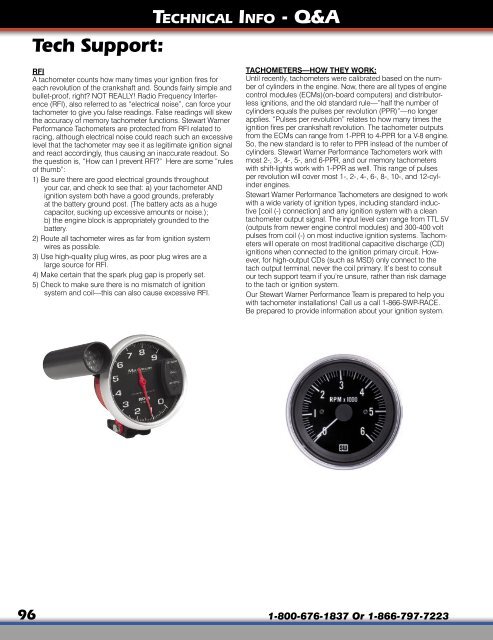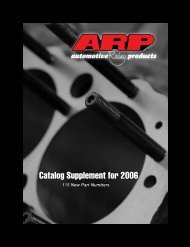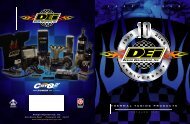Competition Tachs & Gauges - KNS Autosport
Competition Tachs & Gauges - KNS Autosport
Competition Tachs & Gauges - KNS Autosport
Create successful ePaper yourself
Turn your PDF publications into a flip-book with our unique Google optimized e-Paper software.
Tech Support:<br />
TECHNICAL INFO - Q&A<br />
RFI<br />
A tachometer counts how many times your ignition fires for<br />
each revolution of the crankshaft and. Sounds fairly simple and<br />
bullet-proof, right? NOT REALLY! Radio Frequency Interference<br />
(RFI), also referred to as “electrical noise”, can force your<br />
tachometer to give you false readings. False readings will skew<br />
the accuracy of memory tachometer functions. Stewart Warner<br />
Performance Tachometers are protected from RFI related to<br />
racing, although electrical noise could reach such an excessive<br />
level that the tachometer may see it as legitimate ignition signal<br />
and react accordingly, thus causing an inaccurate readout. So<br />
the question is, “How can I prevent RFI?” Here are some “rules<br />
of thumb”:<br />
1) Be sure there are good electrical grounds throughout<br />
your car, and check to see that: a) your tachometer AND<br />
ignition system both have a good grounds, preferably<br />
at the battery ground post. (The battery acts as a huge<br />
capacitor, sucking up excessive amounts or noise.);<br />
b) the engine block is appropriately grounded to the<br />
battery.<br />
2) Route all tachometer wires as far from ignition system<br />
wires as possible.<br />
3) Use high-quality plug wires, as poor plug wires are a<br />
large source for RFI.<br />
4) Make certain that the spark plug gap is properly set.<br />
5) Check to make sure there is no mismatch of ignition<br />
system and coil—this can also cause excessive RFI.<br />
TACHOMETERS—HOW THEY WORK:<br />
Until recently, tachometers were calibrated based on the number<br />
of cylinders in the engine. Now, there are all types of engine<br />
control modules (ECMs)(on-board computers) and distributorless<br />
ignitions, and the old standard rule—”half the number of<br />
cylinders equals the pulses per revolution (PPR)”—no longer<br />
applies. “Pulses per revolution” relates to how many times the<br />
ignition fires per crankshaft revolution. The tachometer outputs<br />
from the ECMs can range from 1-PPR to 4-PPR for a V-8 engine.<br />
So, the new standard is to refer to PPR instead of the number of<br />
cylinders. Stewart Warner Performance Tachometers work with<br />
most 2-, 3-, 4-, 5-, and 6-PPR, and our memory tachometers<br />
with shift-lights work with 1-PPR as well. This range of pulses<br />
per revolution will cover most 1-, 2-, 4-, 6-, 8-, 10-, and 12-cylinder<br />
engines.<br />
Stewart Warner Performance Tachometers are designed to work<br />
with a wide variety of ignition types, including standard inductive<br />
[coil (-) connection] and any ignition system with a clean<br />
tachometer output signal. The input level can range from TTL 5V<br />
(outputs from newer engine control modules) and 300-400 volt<br />
pulses from coil (-) on most inductive ignition systems. Tachometers<br />
will operate on most traditional capacitive discharge (CD)<br />
ignitions when connected to the ignition primary circuit. However,<br />
for high-output CDs (such as MSD) only connect to the<br />
tach output terminal, never the coil primary. It’s best to consult<br />
our tech support team if you’re unsure, rather than risk damage<br />
to the tach or ignition system.<br />
Our Stewart Warner Performance Team is prepared to help you<br />
with tachometer installations! Call us a call 1-866-SWP-RACE.<br />
Be prepared to provide information about your ignition system.<br />
96 1-800-676-1837 Or 1-866-797-7223











